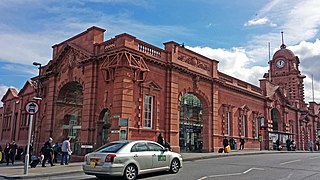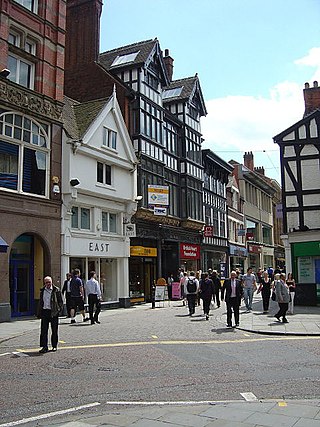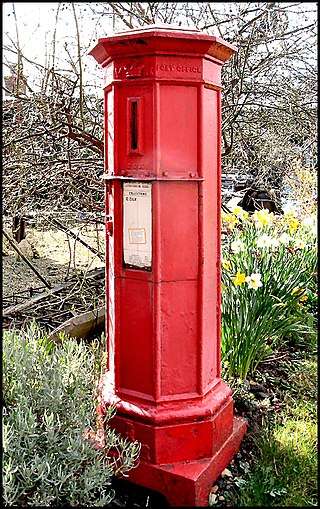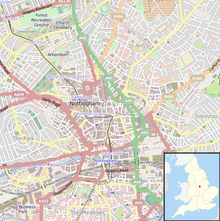
The Midland Counties' Railway (MCR) was a railway company in the United Kingdom which existed between 1839 and 1844, connecting Nottingham, Leicester and Derby with Rugby and thence, via the London and Birmingham Railway, to London. The MCR system connected with the North Midland Railway and the Birmingham and Derby Junction Railway in Derby at what become known as the Tri Junct Station. The three later merged to become the Midland Railway.

Matlock is the county town of Derbyshire, England. It is in the south-eastern part of the Peak District, with the National Park directly to the west. The spa resort of Matlock Bath is immediately south of the town as well as Cromford lying further south still. The civil parish of Matlock Town had a population in the 2021 UK census of 10,000.

Long Eaton is a town in the Erewash district of Derbyshire, England, just north of the River Trent, about 6 miles (9.7 km) south-west of Nottingham and 9 miles (14 km) south-east of Derby. The town population was 37,760 at the 2011 census. It has been part of Erewash borough since 1 April 1974, when Long Eaton Urban District was disbanded.

Nottingham station, briefly known as Nottingham City and for rather longer as Nottingham Midland, is a railway station and tram stop in the city of Nottingham. It is the principal railway station of Nottingham. It is also a nodal point on the city's tram system, with a tram stop that was originally called Station Street but is now known as Nottingham Station.

Derby railway station is a main line railway station serving the city of Derby in Derbyshire, England. Owned by Network Rail and managed by East Midlands Railway, the station is also used by CrossCountry services.

Cromford railway station is a Grade II listed railway station owned by Network Rail and managed by East Midlands Railway. It is located in the village of Cromford in Derbyshire, England. The station is on the Derwent Valley Line 15+1⁄2 miles (24.9 km) north of Derby towards Matlock.

Belper railway station serves the town of Belper in Derbyshire, England. The station is located on the Midland Main Line from London St Pancras to Leeds via Derby, a little under 8 miles (13 km) north of Derby.

Hull Paragon Interchange is a transport interchange providing rail, bus and coach services located in the city centre of Kingston upon Hull, England. The G. T. Andrews-designed station was originally named Paragon Station, and together with the adjoining Station Hotel, it opened in 1847 as the new Hull terminus for the growing traffic of the York and North Midland (Y&NMR) leased to the Hull and Selby Railway (H&S). As well as trains to the west, the station was the terminus of the Y&NMR and H&S railway's Hull to Scarborough Line. From the 1860s the station also became the terminus of the Hull and Holderness and Hull and Hornsea railways.

Nottingham Victoria railway station was a Great Central Railway and Great Northern Railway railway station in Nottingham, England. It was designed by the architect Albert Edward Lambert, who also designed the rebuild of the Nottingham Midland station.

Beeston railway station is a Grade II listed railway station on the Midland Main Line which serves the town of Beeston in Nottinghamshire, England. It lies 3.2 miles (5.1 km) south-west of Nottingham railway station, and 750 metres (0.5 mi) south-east of Beeston transport interchange for local buses and Nottingham Express Transit trams. The station is managed by East Midlands Railway.

Nottingham and District Tramways Company Limited was a tramway operator from 1875 to 1897 based in Nottingham in the United Kingdom.

Bridlesmith Gate is a pedestrianised shopping street in the city centre of Nottingham, England. It is located between Middle Pavement and Victoria Street. St. Peter's Gate and Bottle Lane stem off it along with Byard Lane.

Mansfield railway station is a railway station which serves the town of Mansfield in Nottinghamshire, England. Alternatively it is named Mansfield Town, to distinguish itself from the GCR's former Mansfield Central and Mansfield Woodhouse's station. The station is 17 miles (27 km) north of Nottingham on the Robin Hood Line, and is managed by East Midlands Railway. The station building is Grade II listed.

Andrew Handyside and Company was an iron founder in Derby, England, in the nineteenth century.

Edwardian architecture usually means a Neo-Baroque architectural style that was popular for public buildings in the British Empire during the Edwardian era (1901–1910). Architecture up to the year 1914 may also be included in this style.

Nottingham Carrington Street railway station was the first railway station in Nottingham, opened in 1839 by the Midland Counties Railway. Initially there were two lines with a central platform as well as side ones according to Billson. Victorian civil engineer Francis Whishaw described the station as:
"The elevation next to the road to Nottingham is of plain but neat design. It consists of a central portion and two wings; the central portion contains the entrance hall, which is of the whole height of the building. In the right wing is the booking office for first and second class passengers, with windows at which the passengers receive their tickets; the third class passengers obtain their tickets at a counter fixed in the hall. In the left-wing is the boardroom and clerks offices; and in a building projecting towards the passenger shed in the rear is a waiting room for ladies. The [train] shed is covered with a light iron roof in two spans, which is supported on the departure side by a brick wall, in which there are eight windows; and on the arrival side, and along the middle line, by two rows of cast iron columns, nine in each row."

William Dymock Pratt was an architect based in Nottingham, England

Long Row is a row of retail buildings in Nottingham City Centre forming the north side of Old Market Square, Nottingham.

Albert Nelson Bromley was an English architect based in Nottingham.

William Beedham Starr JP was an architect based in Nottingham.





















